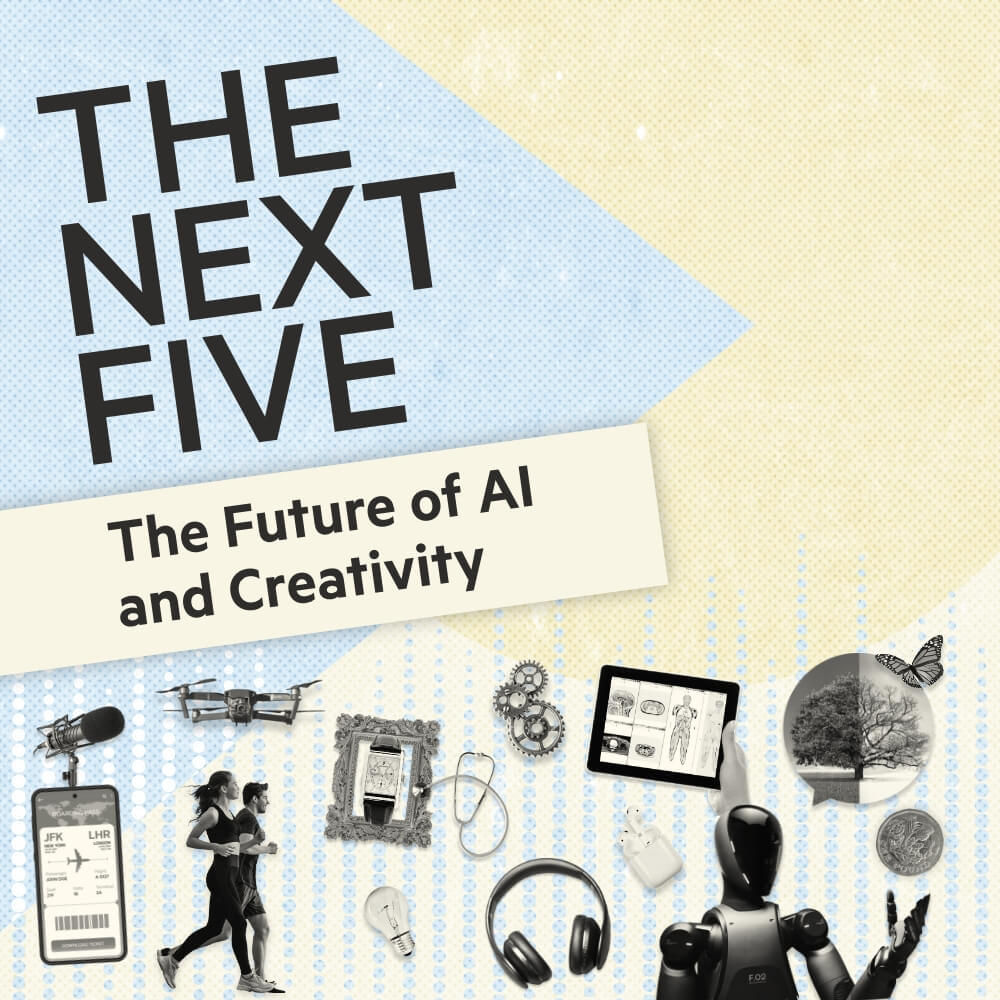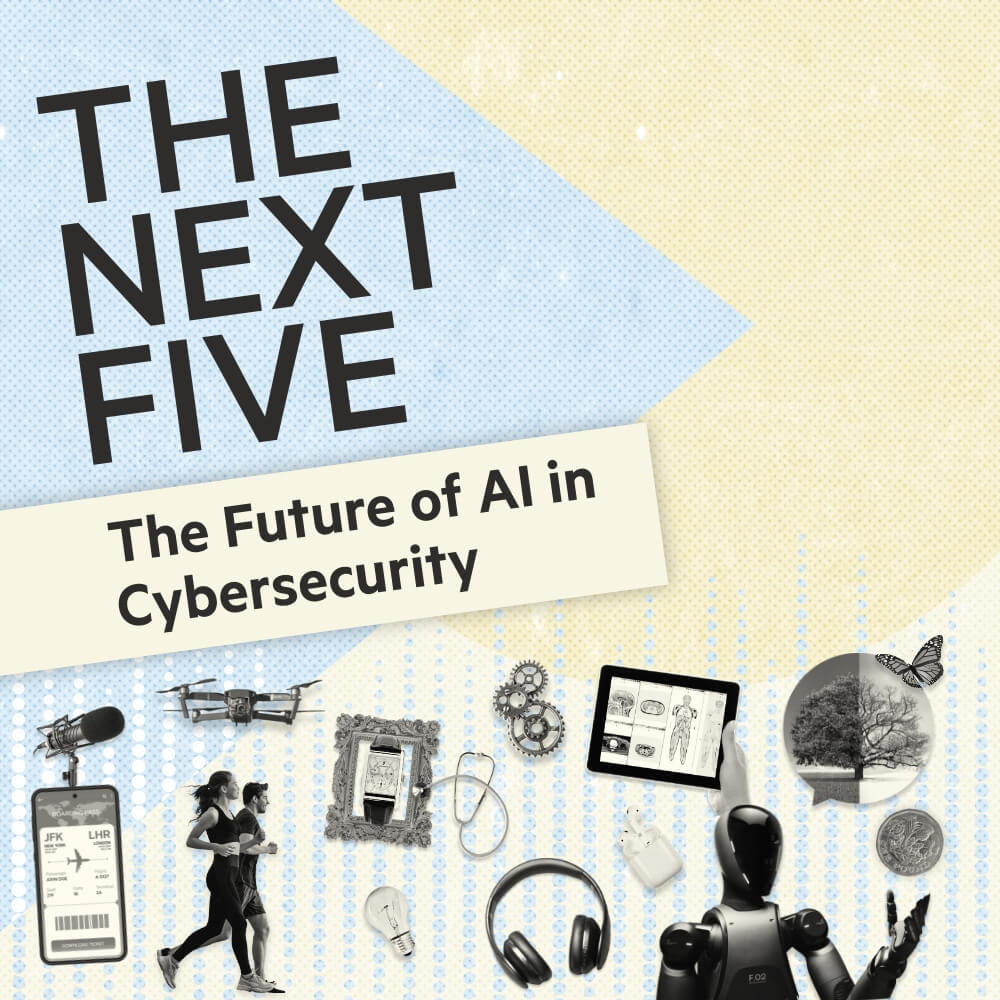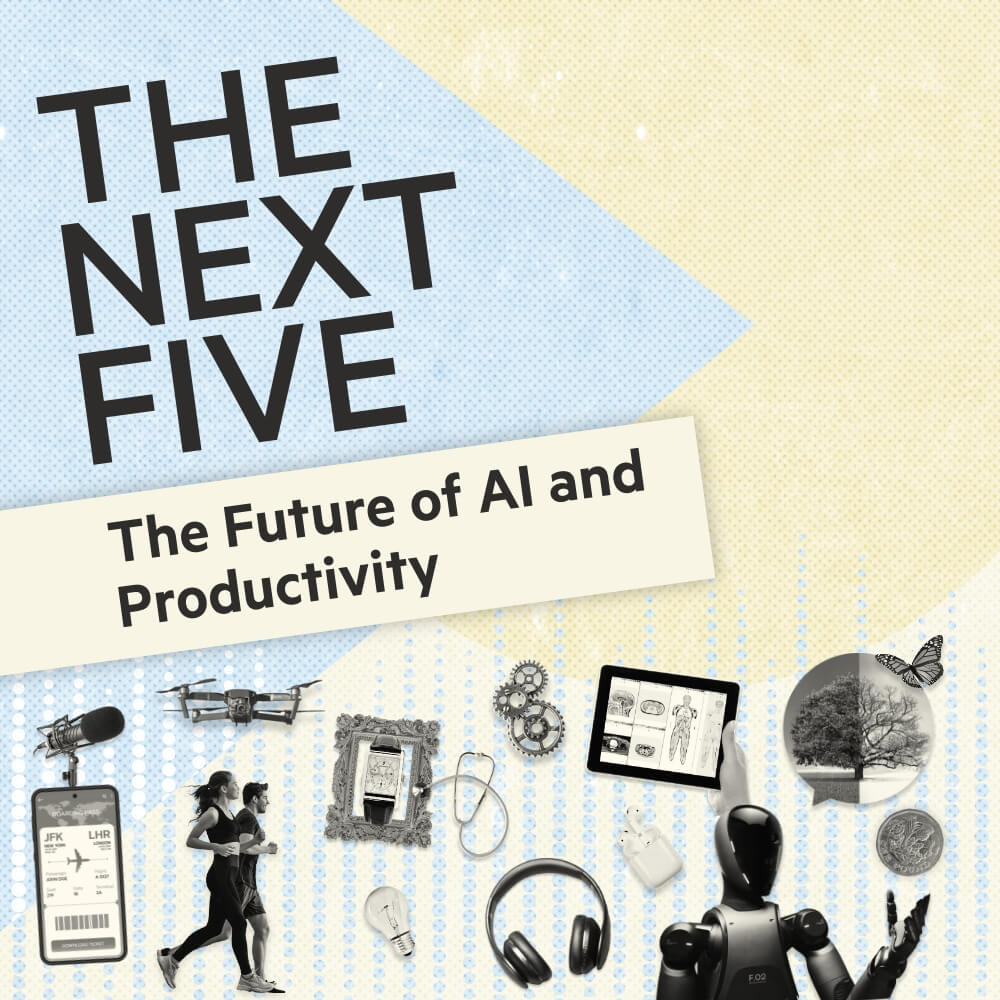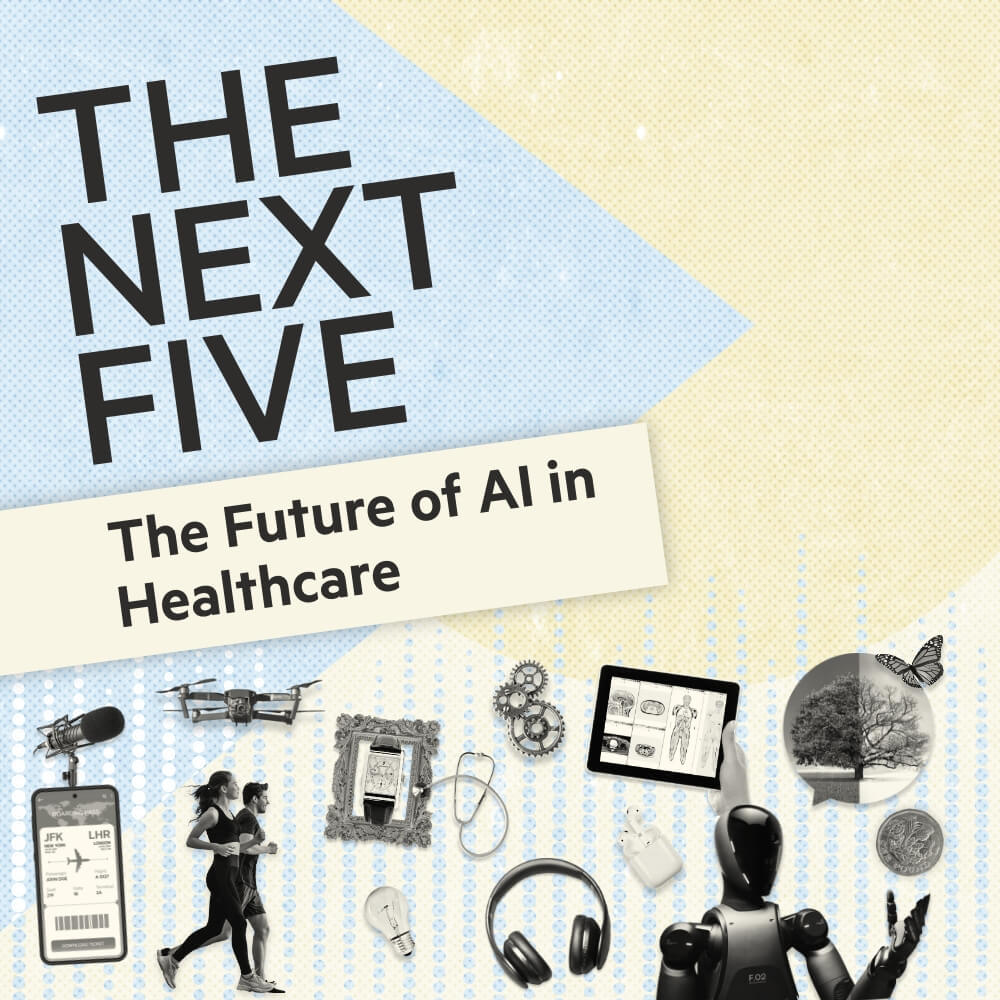THE NEXT FIVE
THE NEXT FIVE - EPISODE 17
The Future of AI in Sustainability
AI, Agriculture and food systems: experts discuss the reinvention of our whole food system and how AI can play it’s part






































The Next Five is the FT’s partner-supported podcast, exploring the future of industries through expert insights and thought-provoking discussions with host, Tom Parker. Each episode brings together leading voices to analyse the trends, innovations, challenges and opportunities shaping the next five years in business, geo politics, technology, health and lifestyle.
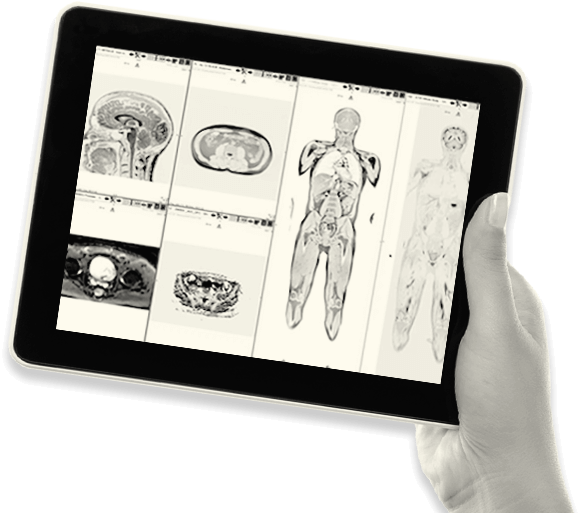


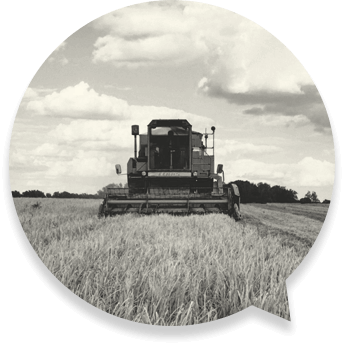












Featured in this episode:
Tom Parker
Executive Producer & Presenter
Faustine Bas-Defossez
Director for Nature, Health and Environment at the European Environmental Bureau
Katharina Schmidt
CEO of APIC.AI
Adam Elman
Head of Sustainability, EMEA, at Google
We are in the sixth mass extinction phase and it’s primarily driven by human activity. Globally, 1.2 million species are at risk of extinction and around 70% of the planet's ice-free land has already been altered, primarily for agricultural use. In the second episode of this five-part miniseries, we look at AI's role in sustainability and how it can help us better understand the natural world.
In Europe, unsustainable farming and forestry, urban sprawl and pollution are predominantly to blame for a drastic decline in biodiversity. This latest era of extinction in the natural world also comes at a time when we are making giant leaps in an artificial realm and while AI is no silver bullet it could help us better understand how to sustainably reinvent our agriculture, farming and food systems. Protecting species is also of the utmost importance. Insects, for example, are an important piece in the biodiversity puzzle and are under threat. But AI can help us understand our insect friends and the environment they serve. In this episode we speak with Faustine Bas-Defossez, Director for Nature, Health and Environment at the European Environmental Bureau, which is the largest federation of environmental NGOs in Europe, where she discusses how AI can help understand the problems that exist within the agricultural industry and the importance of transforming our food systems to a more sustainable, circular model. Katharina Schmidt, CEO of APIC.AI, an AI startup from Germany that monitors bee populations, tells us how AI models are helping to analyse individual bee behaviours in a hive of 50,000, and what this tells us about the health of our environment. Adam Elman, Head of Sustainability, EMEA, at Google further extols the value that AI can bring to mapping key environmental change and the value of data sharing on a global scale.
Our Sources for the show: FT Resources, WWF, LSE, European Parliament, Royal Society, United Nations.
READ TRANSCRIPT
- Tech
- Climate
Transcript
The Future of AI in Sustainability
TOM
I'm Tom Parker, and welcome to the next five podcast brought to you by the FT partner studio. In this series, we ask industry experts about how their world will change in the next five years, and the impact it will have on our day to day. We’re continuing our special 5 part mini series where we take a deep dive into the world of AI. Each episode is focusing on an industry sector where AI is having and is set to have a big impact.
This second episode in the series is all about AI and biodiversity, agriculture and sustainability, where we’ll be looking at AI’s application and limitations in these sectors, and if AI over the next five years can help us reach a sustainable, biodiverse and food secure world.
MUSIC FADE
Tom: Globally, 1.2 million species are under threat of extinction. The world is now entering its 6th mass extinction phase with species disappearing 10-1,000 times faster than normal rate of extinction, driven primarily by human activity.
Humanity’s destruction of habitats in Europe has seen bird populations decrease by over 600 million since 1980, a fifth of the total population. One in every ten bee and butterfly species on the continent are also on the brink of extinction, while over 70% of plant species in Germany alone face a similar fate.
Unsustainable farming and forestry, urban sprawl and pollution are predominantly to blame for a drastic decline in Europe’s biodiversity.
Ergo, preserving our planet's delicate ecological balance is vital for a healthy and sustainable ecosystem.
Faustine (00:50.55)
Well, according to many scientists, we are faced with the six-max extinction, which is quite frightening.
TOM: This is Faustine Bas-Defossez, Director for Nature, Health and Environment at the European Environmental Bureau, which is the largest federation of environmental NGOs in Europe
Europe's biodiversity continues to decline at an alarming rate, with most protected species and habitats that are confronted with poor conservation status. Actually, over the last 40 years, Europe has lost over half a billion birds, which is dramatic.
In the context of the climate crisis also, it is worth stressing that the climate and the biodiversity crisis are interconnected and that they are feeding each other. So not only we're faced with a biodiversity crisis, but this is also strengthening the climate crisis that we're faced with. And it is preventing us from being able to adapt to climate change. But at the same time, climate change is also strengthening the biodiversity crisis.
and I talked about the six mice extension. And actually not only it's frightening, but the big difference between that extension and the previous ones is that this is led by humans. It is driven by humans. And now looking at what is the major driver of biodiversity loss in the EU, actually agriculture is not just one of the reasons behind the loss of biodiversity.
but it is reported by literature, by evidence, as being the highest, I mean the major reason behind the biodiversity loss in the EU. It is the largest contributor to that loss. It is the contributor to biodiversity loss through several reasons, conversion of natural ecosystems into agricultural land, so the change of land use, destruction of habitats for biodiversity intensification of management and use of land, meaning an increased use of chemical inputs, pesticides, mineral fertilizers, also monocropping, tilling and release of pollutants.
Tom: Biodiversity loss caused by the agriculture industry is one problem, but food systems also account for around 30% of greenhouse gas emissions. Is there a way to reinvent our agriculture, farming and food system and what role can AI play here?
Faustine (03:07.926)
It's well understood and also backed by a lot of evidence and facts that our entire food system is broken and that it is deeply unsustainable. Today our industrial food system is making us sick. First of all, it is driving deforestation. It is polluting the air that we breathe, the water that we drink.
Faustine (05:44.998)
We need to urgently move towards sustainable food systems which support our health, the health of our farmers, protect and restore our natural world, natural habitats, and respect workers. There is a strong role for the or the European Union.
Faustine (06:13.698)
that can and must lead this transition. So we need several things. We need to change the parting in how we produce from moving away from that quantity focus to quality, from extractive and input intensive agriculture to regenerative and agroecological and circular agriculture.
move to farming that eventually works with nature and not against nature and also becomes much smarter in the way we are using natural resources and all resources in general.
artificial intelligence in itself is not going to lead to a complete rethink of farming practices. We need deeper system change for that, that's clear. That being said, it can help make farming practices more efficient, less resource intensive, less polluting, more resilient to climate change, and that's urgently needed.
It can also make farmers understand better the actual needs their crops have and understand better their own farms, given that it is providing them potentially with a lot of data. Just to take some examples, regarding biodiversity, what I find particularly interesting is the role artificial intelligence can play for instance in strengthening and foster
biological control and therefore integrated pest management because it can help with the accurate identification of the biological control agents and also help monitor the efficiency of biological control and to make it more efficient and to also avoid certain risks that are associated with biological control.
Faustine (13:15.21)
Biological control is basically using nature, you know, and what you see in nature, so natural enemies to the pests that you can have on your crops.
So for instance, you can use ladybugs to fight against green flies on your crops.
FAUSTINE 12:41
So through AI, you know, you can monitor that. and understand that better and make a better use of biological control, which is a key tool for the change towards sustainable farming and towards the reduction of pesticides use
Artificial intelligence can also support the monitoring of wildlife and help identify species on farmland. And this data eventually helps farmers to take the right measures to protect species that would be endangered and therefore promote biodiversity on their farmland. So this is another very positive and concrete impact that such a technology can have on the fight against biodiversity decline on farmlands.
TOM: Protecting species is of the utmost importance, not just on farmland. Insects, for example, are an important piece in the biodiversity puzzle and are under threat. By the end of the century, the World Wildlife fund predicts 40% of the World’s insect species could be extinct. One such insect, the bee, is a key pollinator and has been suffering from human activity.
Katharina 1 (00:38.198)
Well, first of all, you kind of have to be specific when you just say bees.
TOM: This is Katharina Schmidt, CEO of APIC.AI an AI startup that monitors bee populations.
Katherina 1 00:41
it's honeybees that most people think about, but at least in Germany, there's like 560 different types of bees and when we talk about bees, wild bees, honeybees
Katherina 1 02:20
They are multiplicators of biodiversity. So by flying from flower to flower, they help the plants reproduce and without this kind of ecological service, many, many plants wouldn't be able to exist. And that's kind of like one of the very special properties. So nature has been relying on bees for a really, really long time in order to keep up the ecosystem and biodiversity as well.
Katharina 1 (02:58.506)
So honey bees, they only ever fly on each trip to one kind of flower. So they go poppy, they go home, they go pear, apple, and so on. And that's very special about honey bees because you can't pollinate a pear with a poppy. And this is kind of like this understanding that the entire ecosystem has and this like contract between the honey bees and their surroundings because otherwise pollination wouldn't work. And nobody really knows why they do it.
But it happens and it works and if it doesn't work, our world would look completely different.
TOM: The decline in bee populations call for innovative solutions. By leveraging AI technologies farmers and conservationists can gain insights into bee behaviour, migration patterns, and habitat preferences. This is where Katherina and Apic.AI come in.
Katharina 1 (06:26.786)
So if you look at a honeybee, you know how the surroundings look. If you see the surroundings, you know what the honeybee is going to look like. And so that's what kind of like gave the idea and how we implemented it is we built a camera system that is attached right in front of the hives.
and all the bees that walk into the hive and come back, they are all filmed. And we just kind of detect every single bee on every single frame of the video, and then we track them throughout the camera's field of view, and when they come back, the same thing. And then we also detect certain features that they have. So honey bees collect pollen. We all know that because that's how pollination works. They also collect nectar, though we can't really see it because it's inside of them.
But we see, do they find pollen in their surroundings? That's their nutrients like fat and vitamins and so on. And if they bring enough of that back home, that's a really good sign. If their behavior regarding activity or that pollen collection changes, that's not a good sign potentially. And what we also can do that's pretty new is we can mark these. So they get like a little sticky number on their back
so we can detect individuals and see what they're doing and see if there's like an increase in mortality, if there's different recruitment behavior and so on
Katharina 1 (11:10.494)
we use the AI to detect the views and to track the views. So to detect the views as they walk through the camera's field of view and then to also assess whether they have certain features such as pollen or a number on their back that marks them as an individual that we already know.
Katharina 1 (08:47.318)
And that's kind of like the way that we use the technology in order to create data, which then can be interpreted to derive insights about potential problems that substances or environmental factors have.
TOM: And this is where AI really helps, it can process that data at much quicker speeds than a human could.
Katharina 1 (09:18.587)
So to give you a perspective of like one single colony per day, we have like, 40 million detections. So every single bee is detected on every single frame of this entire video. There's like up to 50,000 bees in a hive in the summer, like at their biggest. And every single bee must be looked at. So you have all this movement, but you want to see this bee, like Berda, for example, she's walking this way, then she's taking three circles and then she's going back.
That's the kind of data that we want to get. And we also want to see, does the bee have pollen? Does it not?And that's kind of what we do. So 40 million detections, and then you have 120,000 movements in and out of the hive.
TOM: This data-driven approach empowers conservationists, farmers, companies and policy makers to make informed decisions, design targeted habitat restoration projects, and implement strategies that safeguard pollinators and other animal populations.
Where there are startups, there are also large organisations using AI to tackle the sustainability and biodiversity problem by mining huge amounts of data
Adam Elman (00:30.839)
So the transition to a more sustainable future will require billions of decisions by people, cities, governments, and organisations around the world.
TOM: This is Adam Elma, head of sustainability, EMEA, at Google
And as an information company, and with the breakthroughs in artificial intelligence, AI, and our deep legacy in research, we're building the tools and the solutions that help inform those decisions
Adam Elman (04:45.123)
So we have, for many years, had a solution called Google Earth Engine, which brings together satellite imagery, lots of planetary data sets, and planetary scale data analytics. And we actually have information going back four decades. And that solution is being used along with AI capabilities, again, helping companies and governments and cities around the world.
with responsible management of natural resources and really helping them assess the impact and the changes to our planet. And actually, if you search on Google, you can see time lapse videos that actually go back four decades that really show the impact to changes to our planet, whether that's negative changes, such as the impact of deforestation, or seeing the positive impact of changes, such as large-scale solar arrays being deployed.
Adam Elman (01:55.539)
how we're helping in terms of biodiversity and natural resources.
Adam Elman (03:50.236)
So Mineral AI, which is an alphabet company, is working to build a more sustainable and productive food system. So the team is joining diverse data sets in radically new ways, from soil and weather data to drone and satellite imagery, and using AI to reveal insights that have just never been possible before about what's happening with crops.
Adam Elman (05:41.819)
So again, it's really taking these different data sets, taking the information and using AI to really make it accessible and useful.
Tom: urban sprawl and pollution are another major cause of biodiversity loss.
Adam Elman (01:55.539)
Cities are really interesting because cities actually account for around 70% of global greenhouse gas emissions. And they have big ambitions, but often lack the data and the tools to know how to take action. So for example, Project Greenlight, which is a tool developed by Google Research,
leverages AI to help cities optimize traffic light, thereby reducing emissions and making traffic flow more efficiently. And green light is more actionable and scalable and cost effective for cities than alternative solutions, because it works with existing infrastructure and traffic systems. So city engineers just need to monitor the impacts and make tweaks to their system, and they can see the real impact.
And cities are really struggling with things like extreme temperature changes and poor air quality. And this is another area where we and technology such as AI can help. So we have a tool called the Environmental Insights Explorer, or EIE for short. It's a solution that helps cities identify areas of opportunity for emission reduction and climate change adaptation projects.
TOM: Access to data and using AI models to paint a quicker and more accurate picture of biodiversity loss, climate change and agricultural impact promise significant benefits.
TOM: But equitable access to data and AI systems is a challenge.
Faustine (23:55.054)
What we've seen is that artificial intelligence is not, actually often, not appropriate for small and mid-sized farms. So it is tailored for large-scale farms, and as a consequence it is only supporting or fostering change for those that produce in reality a few.
community crops on a larger scale because small farmers are actually producing a large diversity of crops. So that's one of the limitations is that this is tailored for larger scale, not necessarily for small and mid-sized farms. And that is one of the limitations of it.
And maybe a last point on data. With data, you also have the issue, of course, of the ownership of the data and the question of sovereignty, of control. Of course, we need to make sure that these are available
And we need to make sure that there is no monopolistic control over the data, because the data are key to understand the need to change and to act a change, to understand the problem and to act as we should.
TOM: Adam, weigh in here if you can?
Adam Elman (06:37.879)
part of the challenge here is there's often a lot of data, but it's often very fragmented across lots of thousands of silos and a multitude of data sets. But when you combine that information,
With the power of AI, we can really transform how decisions about sustainability are made. So one example is Data Commons, which is an initiative from Google which organizes publicly available data sets and makes it accessible and useful, really showing how bringing these things together can make an impact. So for example, Data Commons can take data sets from, for example, the United Nations Intergovernmental Panel on Climate Change, the IPCC.
by aligning on data on locations and health conditions and data sets so that it can really be useful. And when we combine it with AI, it then becomes not only useful but accessible. And Data Commons is now harnessing the power of large language models, such as LLMs, to create natural language interfaces so that a user can actually just ask simple questions like what are the sources of greenhouse gas emissions in Germany?
Or what is the solar energy consumption in the EU? Or even more complex questions like, how does solar installations correlate with the median income of EU countries?
Adam Elman (17:19.191)
So we're really focused on working with trusted partners around the world so that we can get the best data, the best science, and the best information available. And it's something we're looking at right across our work on AI. And we must be both bold, but we really must be responsible. So it's something we're very mindful of, but it's one of the reasons we work with really trusted partners to make sure we're using the right and the most credible data.
TOM: The digitisation of industries like agriculture opens the door to another challenge. cyber attacks. In May 2021, Brazil based meat processing giant JBS suffered a ransomware attack that took it offline, affecting facilities in the US, Canada and Australia. The company was forced to pay $11 million dollars to end it. A smaller co-operative, Iowa based New Cooperative Inc that provides grain for 11 million farm animals in the US suffered a similar ransomware cyber attack in September 2021. Is the agricultural industry ready for this new digital AI driven world?
Faustine (26:30.934)
Well, whether they are ready for changes, I mean, there is a lot of push for maintaining business as usual. I mean, we see across the EU and here in Brussels, you know, the largest farming union.
keeps lobbying for as little change as possible and using every possible opportunity, sadly, even, you know, what we've seen with the war in Ukraine, and to instrumentalize the food security argument, basically, not to do anything on the environment and to reduce biodiversity loss and...
and to be more water resilient and climate resilient, etc. We need an enabling policy framework to change that, but we also need to have deeper changes in the governance around farming in general.
Faustine (22:27.998)
The problem is that when it's about data, speaking about data, we still see resistance actually. And we do, as environmental organizations, we notice that, we see that quite often, that there is resistance from farmers themselves, but also from agriculture ministries in collecting more data. Because for now,
they can hide behind the lack of data for not changing anything, for not moving. Once there is data that is available, obviously it's much harder to hide the problem. So artificial intelligence for that is great because it is exposing the problem much more than it would without having the data.
Faustine (28:53.934) Because for now I hear often from farmers who have moved away, let's say, from business as usual and highly intensive farming models to more sustainable, regenerative agriculture and they say that it's a very agroecological transition.
It's still very difficult because you're not part of the system anymore, and we need to make sure that access is there and that the ones who do that are not marginalized because otherwise you need to be very brave and very eager for the changes to do that. And you cannot, you know that most of the farmers will do that and I would understand them because it's very hard.
TOM: So what do the next five years look like for biodiversity? Katharina
Katharina (28:20.706)
The loss of species seems to be accelerating.
Katharina (27:59.374)
I think in five years the situation will be even worse because it will be progressing the way it is right now. If it does progress the way it has progressed for the last couple of centuries, it will be worse than it is today.
Katharina (28:26.706)
And right now we don't really know what to do about it. There are those kinds of activists that say we have to stop everything,and we have to prioritize the protection of those species.
What I'm always hoping for is to find a middle way to collect more data or better understand the ecosystem in order to find ways to produce crops and feed the planet while still not harming nature. And I'm not sure yet how this can be done. We are trying to do our little bit by collecting data on one species that's kind of like in the middle of it all. That's what I can do.
Katharina (29:28.834)
And one thing that I feel is like wrong allocation of resources is like the best people should work on the most pressing issues. And the most pressing issues are not necessarily the ones that pay best. That's really unfortunate because a lot of people, like when it comes to AI, all the workforce is bound.
in questions that do not concern biodiversity at all. So what I would hope for is that there are more companies such as ours that find ways to put the good people to the most important challenges and not those that earn the most money, but the ones that have the biggest impact. And I hope that there will be more companies that find business cases in the way of making the world a better place and to apply people from AI in order to collect data and make it usable that has not been there before in order to make us.
Katharina (32:13.162)
help us make better decisions to not mess up the planet.
TOM: Adam what about Google, AI and sustainability as a whole over the next five years?
Adam Elman (23:49.123)
So I've been working in the sustainability space for 20 years, and science is clear. Climate change is an urgent threat to human well-being and the health of our planet. And this really is the decisive decade. So to avert the worst impacts of climate change, science demands that we halve global greenhouse gas emissions by 2030. And I fundamentally believe that technology is a key part of this, and it really is an unlock to many of the solutions that we need.
Adam Elman (19:42.763)
So I'm really excited about the role that technology is playing today, and increasingly will over the next five years. We're seeing the innovation in technology really leapfrog, and it's critical to the transition we need for a lower carbon future that we both want and need for our planet.
We actually commissioned research last year from a group called Implement Consulting, and they specifically looked at the opportunity for technology in helping Europe with its net zero 2050 target. And the research showed that around 20 to 25 percent of the reductions required will require some form of digital decarbonisation. To put that in perspective, that's the emissions equivalent of France and Germany combined.
Adam Elman (20:48.727)
So what I really hope for is that we really do scale up the needs of these technologies. The good news is the technologies and the solutions we need are here today and can already have a really big impact. And we're really working together across society in partnership with others where we're gonna achieve the results that we really need for this low carbon future for our planet.
TOM: And finally Faustine, what about the next five years in agriculture and AI incorporation?
Faustine (33:21.666)
Yeah, well, it's very hard to see any meaningful change in the system in the five years to come because there is no political will for setting the framework that is needed for the change to happen because we know that business as usual is everything but a good thing for the farmers, because...
The enemy is not the policy and more environmental policy potentially or climate related policy, but climate change itself and the biodiversity collapse itself as well.
Faustine (35:36.326) So in the next five years, yeah, big question mark also because the policy that is for now influencing farming practices, the so-called common agricultural policy, which is more than 30% of the EU budget.
Faustine (35:49.702)
despite its last reform, is still very much driving business as usual, and is not driving changes at farm level. So when it comes to artificial intelligence and other technological solutions, they are developing and they will be picked up more and more by farmers. I mean, there is no doubt about that because they need to...
I mean, regardless of the political framework, they have to adapt to the reality on the ground and on their lands, but without the bigger paradigm change, which itself can only be driven by the right policy framework and the right political will and ambition. Yeah, it's doubtful that it will.
provide some benefits on the environment, but not enough to reverse the crisis that the farming sector is faced with.
Faustine (37:27.99)
What I'd like to see for the next five years is a bold and ambitious framework on sustainable food system that is really reconnecting production and consumption and looking at the whole chain also with retailers, et cetera, in between, because it's not just farmers on the one hand and consumers on the other hand. It's all the actors in between that are extremely...
powerful and relevant also and needs to change and can drive changes as well. So that framework, that policy framework is very important. I very much hope that it will be and it should be put forward.
in the next five years, So if you have this enabling framework, then you would have a policy that eventually helps farmers with the transition.And eventually also rewarding farmers for, once they reach that point, for the public goods and biodiversity maintenance and if it's also on water or on soil, like keeping soil health, maintaining soil health, soil biodiversity.







